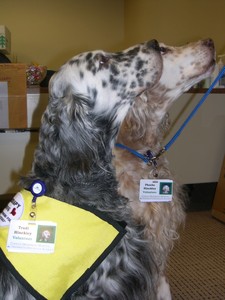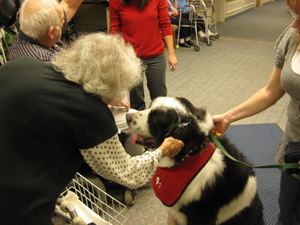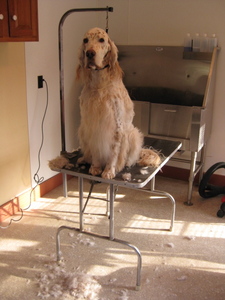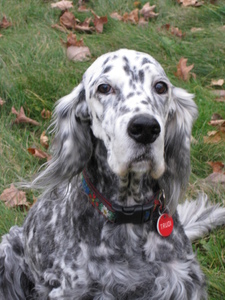A new resident in the Alzheimer’s unit, Constance has refused to come out of her room. Her hearing is compromised, she is disoriented, and has difficulty communicating. Attempts to get her down to the physical therapy room have been futile. One thing that is known about Constance is that she is an animal lover… Entered James – and the magical connection occurred! Constance smiled and waved her hands making attempts to communicate her desire to spend time with James. The physical therapists wanted to get her up and out of her room, so they told her if she went into the lounge, she could visit with James. She beamed and willingly followed them to a chair in the lounge positioned so she could cradle James’ head in her hands and pet his head. LOTS OF SMILES!!! I love doing this… wish I could spend everyday bringing James to visit with Constance.
All dogs are wonderful – but not all dogs make good therapy dogs
When a dog owner calls me and says: I have an adorable, sweet, friendly dog. He’s so good with people. I know he’ll make a wonderful therapy dog. When can you evaluate him? I get a bit nervous. More times then not, these are the dogs that come galloping in through the door, six foot lead fully extended. The dog has a big smile on his face, tongue hanging out, saying – I’m here. I’m very, very friendly! Or, they’re the dogs whose owners want passionately to be involved with this type of work, but I see them literally dragging their cowering dog in behind them. In both scenarios, the owners are eager to get started. This presents a problem for me as the evaluator.
Dog #1 – our overly exuberant, jolly fellow – clearly is very happy to be in the new environment. Just what I like to see in a therapy dog. The dog is literally smiling. But, he’s quite a bit out-of-control. The owner tells me that the dog is perfect, He sits, stays, heels, downs – all on command – when we’re by ourselves with no distractions. Well, a therapy dog, for the most part, is not alone and there are plenty of distractions. In this case, since the dog clearly is happy to be in the setting, I recommend that the owner work more – lots more – on getting the basic obedience commands solid, testing the dog’s controllability in a variety of settings with distractions (go into public buildings where dogs are allowed and interact with people of all ages, test the basic commands indoors and outdoors). When he is completely controllable, he may very well be ready to be re-evaluated. Here, it’s up to the owner. He must ask himself, Am I willing to put in the time to train my dog for therapy dog visiting? (Of course, in my opinion, this is a mute point for a responsible dog owner. It’s our job, we owe this to our dogs, whether or not they become therapy dogs.) I have found that those who are committed to doing this with their dog have had a successful outcome.
Dog #2 is more difficult to turn around. If your dog is truly unhappy about being in a strange place, is shy or timid, it will take a lot of positive training and socialization to reverse this situation. The dog may have solid obedience commands – unlike dog #1 – and pass the obedience portion of the evaluation with flying colors, but be very unhappy and stressed out when interacting with strangers. It really isn’t fair to force the issue – this is not the overall package that makes a good therapy dog. A good therapy dog is happy while doing his job. It’s hard for me, but in cases like this, I recommend to folks that they not pursue therapy dog visiting. This recommendation in no way means that their dog is not wonderful – all dogs are wonderful – but not all dogs make good therapy dogs.
The Holiday Season
Not always a happy time… MERRY! HAPPY! JOYFUL! Words we hear throughout the the holiday season. We greet people we see by saying Have a Merry Christmas! Or, end a conversation with Happy New Year! We are surrounded by holiday music and people talking about their family plans for the holidays. Be cognizant when making visits with your therapy dog that folks in facilities may not be seeing anyone, or doing anything during that period when supposedly everyone is jolly. In particular, patients in mental health facilities have a very hard time getting through this period. For them, holidays may conjure up very unpleasant memories; residents in nursing homes may not have any relatives nearby to visit them on Christmas. Stop for a moment and think what it would be like… then, think about how happy people are when you visit with your therapy dog… your DOG and YOU are creating the joyful moment. The opportunity for the person you’re visiting to spend time with your dog; perhaps the dog showers her with kisses, cuddles in her lap, or just lies down by her feet. If the patient was sitting sadly thinking about holidays past, your presence has brightened her day. Often, I have taken a photo of my dog with the patient ahead of time – then given it to the patient at that particular visit. She then can enjoy looking at the photo after we have left – which brings to mind HAPPY thoughts. Visiting folks at the holidays is very important. Try not to miss your regularly scheduled visit – and perhaps you can make it a bit longer. The gift of comfort and caring will bring immeasurable JOY.
Can my dog go into stores when he’s wearing his therapy dog vest?
If the sign in the store window reads Service Dogs Only, then your dog – whether he’s wearing his therapy dog vest or not – is not allowed in the store. Your dog is welcome wherever the sign reads Dogs Welcome. In other words, your dog, as a certified therapy dog doesn’t have any special rights in public places. He does have special rights in healthcare facilities and eduational institutions where a dog is welcome only if he has been certified through a therapy dog organization.
The misunderstanding comes when people confuse the terms Service Dogs and Therapy Dogs. They are not synonymous. Simply put, Service Dogs are trained to help their owners; Therapy Dogs are trained to work with their owners to help others. Therapy Dogs are visiting dogs that make scheduled visits to healthcare facilities, assist in educational programs, and anywhere else that therapy dogs can help others.
Is there a certain breed that makes the best therapy dog?
This is one of the most frequently asked questions. Just the other night, while attending a gallery opening, the conversation with a group of folks turned to my work with therapy dogs – once again the breed question came up. If one were to take a census of our Bright Spot therapy dogs, one would come up with more – you guessed it – Golden Retrievers, followed by Poodles (all sizes), then Cavalier King Charles Spaniels. However, from my 13 year experience evaluating dogs for this work, I’ve had 2 out of every 3 Golden Retrievers not pass. Either they simply weren’t ready for therapy work (meaning they showed promise, but needed lots more training) or they weren’t cut out for the work. Again, in my experience, all the poodles I’ve seen have been great, but 1 out of every 2 Cavaliers were timid and would withdraw from touch.
Today, I evaluated my first Newfoundland. Boy, did he win everyone over! What a show stopper! He had staff coming out of their offices and residents coming out of their rooms in their wheelchairs and walkers. The perfect therapy dog moment occured – lots of conversation was generated and a great deal of movement. Everyone wanted to pet this friendly fellow!
Really, I’ve seen many breeds, including mixed breeds. Just like people, some are suited for this work, others are not. I need to see a dog that is happy and wants to be there.
Hospice: Therapy Dogs Making a Difference
 Hospice care provides support and comfort to patients having a six-month life expectancy. Volunteers interested in working with patients on hospice care go through an extensive training period to prepare for this type of work. The work can be emotionally draining, but extremely rewarding. You become a part of the circle of support for the person, and for the family of the individual, as well.
Hospice care provides support and comfort to patients having a six-month life expectancy. Volunteers interested in working with patients on hospice care go through an extensive training period to prepare for this type of work. The work can be emotionally draining, but extremely rewarding. You become a part of the circle of support for the person, and for the family of the individual, as well.
In training, one is taught that silence is often what is needed from a hospice volunteer… regular, everyday subject matter is unimportant. Being silent can be hard for humans, we feel compelled to fill the silence with words. Listening, too, is equally important. Whether it be the patient that wants you to sit silently and listen to everything he wants to say, or the family member that needs someone to talk to. We need to train ourselves, as human beings normally talkative and avoiding silence, to sit silently and listen – if that is what the situation calls for.
This is where therapy dogs make great hospice volunteers. They are naturals when it comes to providing a quiet, listening ear. They provide what is greatly needed at this stage – soft touch, and a feeling of warmth and caring. A therapy dog will sit in a chair next to the patient, lie down at his feet, or lie alongside him in bed and listen quietly for a very long time.
One of our Bright Spot volunteers reports that patients will frequently pet her dog Suzie and launch into conversation about the dogs in their lives, they then continue to talk about many other things, all the while petting the dog. Family members or the attending care provider have often told her that prior to her visit with Suzie, the patient had been sad, reluctant to talk, had a variety of discomforts, but after the dog’s visit, the patient was more positive, talking more and taking more interest in life and activities. Another volunteer visiting hospice patients with her toy poodle, Buddy tells me that she tucks tiny Buddy right in bed with the patient. He gives them kisses and they make a fuss over him. A volunteer that visits a hospice patient in her home with her two small Portuguese Podengos tells me that the patient adores the dogs and giggles the entire time. One dog sits up on the patient’s lap while the other sits on the floor next to her and she gives him a brushing. Her children are very happy that their mom gets a regular visit from both two-legged and four-legged friends. This volunteer believes that their visits have had a positive impact on the health and wellbeing of the patient.
The Director of a local Hospice Life Care Program has told me that she loves to have therapy dogs visit the facility. She has witnessed dramatic changes in Alzheimer’s and Dementia patients. Typically these patients show little eye contact, movement, and utter very little speech, but when a therapy dog visits, they focus on the dog, pet him, smile, and often try to speak. The dog’s presence touches something in them that may trigger a memory – something. Something is triggered that no human is able to elicit. Patients that don’t want a human volunteer visitor will accept the dog visitor, let the dog jump up on the bed, pet and talk to the dog – then turn and talk to the dog owner.
Clearly, therapy dogs provide socialization, diversion from pain, and pure enjoyment. As volunteers, one finds comfort in knowing that our visits with our therapy dogs have helped the patient die peacefully and comfortably – the goal of the Hospice Program.
Bath and trim today
When your dog is a visiting therapy dog, he or she needs to be clean and well-groomed. It’s a good habit to get into with any dog. We had an Irish Setter named Breezy – a terrific dog; not a therapy dog, but our fabulous family dog. She had a regular routine of grooming and bathing. She just loved to be clean (and adored the one-on-one attention she got). Since James visits hospice patients, he gets a quick bath every week. Today he got his trim, as well. Just part of his routine, he’s fine with it. Groom your dog on a regular basis – including clipping his nails, and he’ll simply get used to it and expect it.
Tough visit
My first visit back to Julia’s nursing home… the place she visited every week and reveled in the attention she received from both residents and staff. James did a terrific job – he always does. But, everyone asked, “Where’s Julia?” There were many tears… Today we took the first step. We’ll go back now, week after week. The visits are so important to everyone there.
What’s in a name
Retirement time for your therapy dog
Watch for signs that your therapy dog needs to retire. This can be tough on you… you love what you’re doing. Folks look forward to seeing your dog week after week. You want to keep it up – but your teammate has had enough. This could happen for many reasons: advancing age, arthritis, or just simply – your dog doesn’t enjoy doing it anymore.
For me, Trudi loved visiting with her pal Phoebe. Together they visited patients in a mental health unit in an area hospital. What a pair they were! The patients – and staff – loved their weekly visits. When Phoebe died very suddenly, Trudi didn’t want to go on her own. Several weeks after Phoebe passed, Trudi and I made a first visit back to the unit. She literally balked at the door and refused – yes refused – to budge. She wouldn’t enter the unit. She was done – and I had to respect that.
Therapy visits are hard work for dogs. They’re working the entire time. Watch for what your dog is telling you. When they’re not happy doing it or physically, they’re having difficulty doing it, it’s time to stop. If you want to keep visiting, get another dog. That’s what I did.







